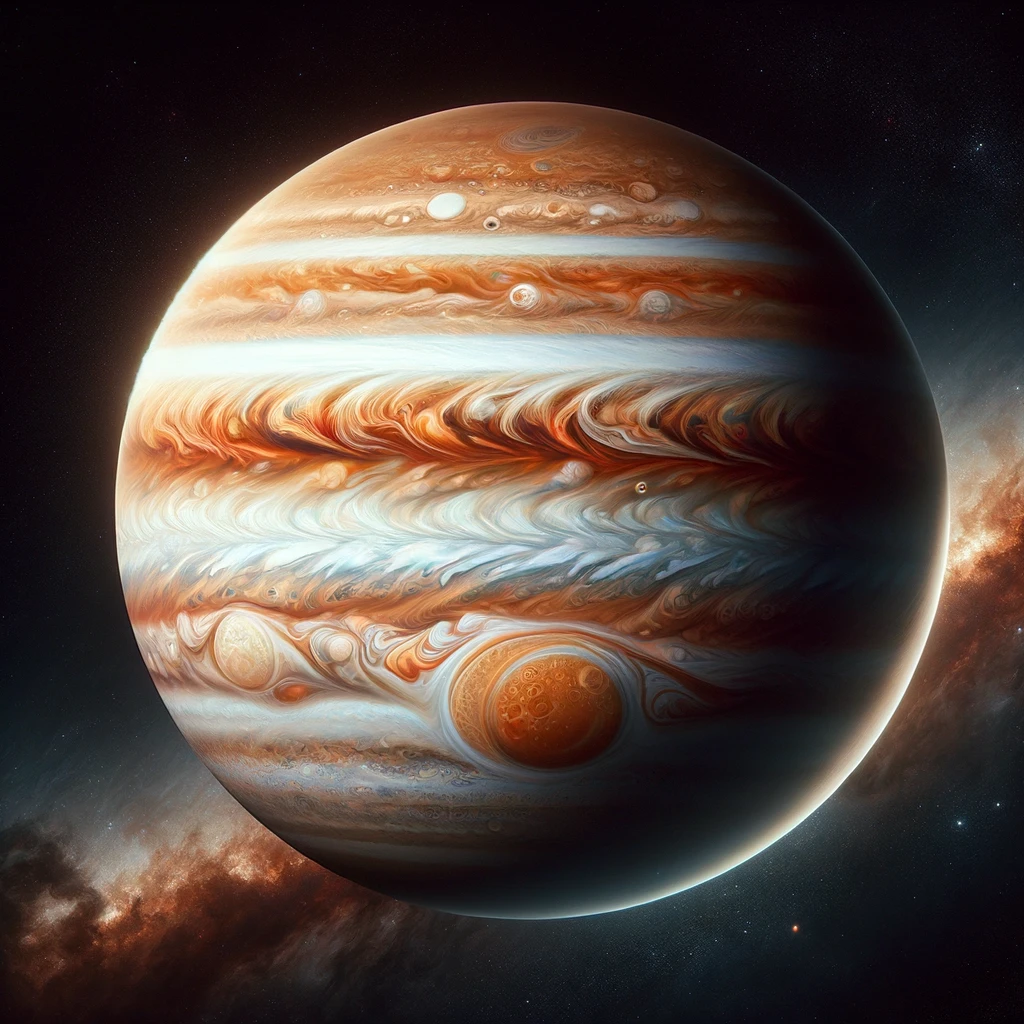
The Colossal Size of Jupiter
Jupiter, the largest planet in our solar system, dwarfs all other planets. It’s so massive that it’s more than twice as heavy as all other planets combined. This immense size influences the orbits of other celestial bodies, showcasing its gravitational might.
Jupiter’s Rapid Rotation
Despite its size, Jupiter spins incredibly fast on its axis. A day on Jupiter is just about 10 hours long. This rapid rotation causes the planet to bulge at the equator, leading to its distinct oblate shape.
The Great Red Spot: A Gigantic Storm
One of Jupiter’s most iconic features is the Great Red Spot, a colossal storm larger than Earth that has been raging for centuries. This storm is so vast that three Earths could fit inside it, marking it as one of the most enormous atmospheric phenomena in our solar system.
Galilean Moons: A Mini Solar System
Jupiter’s four largest moons, known as the Galilean Moons – Io, Europa, Ganymede, and Callisto – were discovered by Galileo Galilei in 1610. Each moon is a world unto itself, with unique characteristics like volcanic activity on Io and a subsurface ocean on Europa.
Magnetic Field: A Shield in Space
Jupiter possesses the strongest magnetic field among the solar system’s planets, which extends far into space. This magnetic field protects the planet and its moons from solar radiation, creating a phenomenon known as the Jovian magnetosphere.
Hidden Rings
Unlike Saturn’s prominent rings, Jupiter’s ring system is faint and consists mainly of dust. These rings were a surprise discovery by the Voyager 1 spacecraft in 1979, revealing a delicate and intricate ring system.
Auroras: Jupiter’s Light Shows
Jupiter’s polar regions are home to spectacular auroras, much like Earth’s. These auroras are caused by the planet’s magnetic field funneling charged solar particles into the atmosphere, creating brilliant light displays.
Atmospheric Bands and Zones
The planet’s atmosphere is divided into bands of clouds and clear zones. These bands, differing in color and composition, rotate at different speeds and directions, leading to Jupiter’s striped appearance.
Hydrogen and Helium: The Primary Composition
Jupiter is primarily composed of hydrogen and helium, similar to a star. However, it lacks sufficient mass for nuclear fusion, the process that powers stars, thus remaining a planet.
The Mystery of Jupiter’s Core
The composition of Jupiter’s core is a subject of ongoing debate among astronomers. Some theories suggest a solid core, while others propose a more diffuse, “fuzzy“ core, blending with the surrounding layers of the planet.
Jupiter’s Influence on Asteroids
The gas giant plays a crucial role in shaping the asteroid belt. Its gravitational pull prevents the formation of a planet from these space rocks, maintaining the structure of the belt as we know it.
Exploring Jupiter: Missions and Discoveries
Humanity has sent numerous missions to explore Jupiter, like the pioneering Voyager spacecraft and the more recent Juno mission. These explorations have vastly improved our understanding of the planet and its moons.
Jupiter’s Potential for Life
While Jupiter itself is unlikely to support life, its moons, especially Europa, are considered potential habitats for extraterrestrial life due to their subsurface oceans and geothermal activity.
Jupiter’s Role in Solar System Formation
Jupiter’s massive size and gravitational influence played a significant role in the formation and evolution of the solar system. Its presence helped shape the orbits and compositions of other planets.
Cultural and Mythological Significance
Jupiter has been a part of human culture and mythology for millennia. Named after the Roman king of gods, it has influenced art, literature, and astronomy, symbolizing power and majesty in human history.



